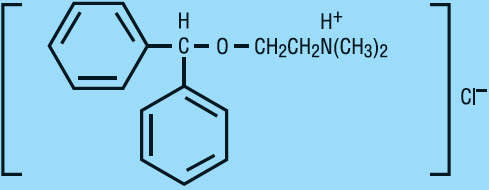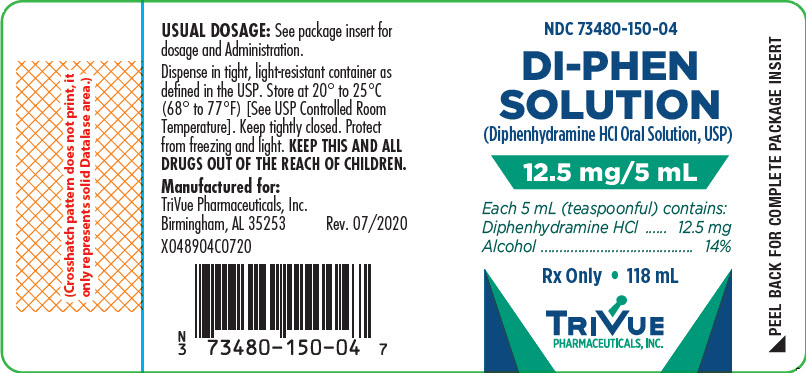DI-PHEN SOLUTION (Diphenhydramine HCl Oral Solution, USP) 12.5mg/5mL
DI-PHEN by
Drug Labeling and Warnings
DI-PHEN by is a Prescription medication manufactured, distributed, or labeled by TriVue Pharmaceuticals, Inc.. Drug facts, warnings, and ingredients follow.
Drug Details [pdf]
DI-PHEN- diphenhydramine hydrochloride solution
TriVue Pharmaceuticals, Inc.
----------
DI-PHEN SOLUTION
(Diphenhydramine HCl Oral Solution, USP)
12.5mg/5mL
DESCRIPTION
Diphenhydramine hydrochloride is an antihistamine drug having the chemical name 2-(diphenylmethoxy)-N, N-dimethylethylamine hydrochloride and has the molecular formula C17H21NO∙HCl (molecular weight 291.82). It occurs as a white odorless, crystalline powder and is freely soluble in water and alcohol. The structural formula is as follows:

C17H21NO∙HCl 291.82
Each 5 mL contains 12.5 mg of diphenhydramine hydrochloride and alcohol 14% for oral administration. Inactive Ingredients: Citric acid, D&C Red No. 33, FD&C Red No. 40, flavoring, purified water, sodium citrate, and sucrose.
CLINICAL PHARMACOLOGY
Diphenhydramine hydrochloride is an antihistamine with anticholinergic (drying) and sedative effects. Antihistamines appear to compete with histamine for cell receptor sites on effector cells.
A single oral dose of diphenhydramine hydrochloride is quickly absorbed with maximum activity occurring in approximately one hour. The duration of activity following an average dose of diphenhydramine hydrochloride is from four to six hours. Diphenhydramine is widely distributed throughout the body, including the CNS. Little, if any, is excreted unchanged in the urine; most appears as the degradation products of metabolic transformation in the liver, which are almost completely excreted within 24 hours.
INDICATIONS AND USAGE
Diphenhydramine hydrochloride in the oral form is effective for the following indications:
Antihistaminic
For allergic conjunctivitis due to foods; mild, uncomplicated allergic skin manifestations of urticaria and angioedema; amelioration of allergic reactions to blood or plasma; dermatographism; as therapy for anaphylactic reactions adjunctive to epinephrine and other standard measures after the acute manifestations have been controlled.
Antiparkinsonism
For parkinsonism (including drug-induced) in the elderly unable to tolerate more potent agents; mild cases of parkinsonism (including drug-induced) in other age groups; in other cases of parkinsonism (including drug-induced) in combination with centrally acting anticholinergic agents.
CONTRAINDICATIONS
WARNINGS
Antihistamines should be used with considerable caution in patients with narrow-angle glaucoma, stenosing peptic ulcer, pyloroduodenal obstruction, symptomatic prostatic hypertrophy, or bladder-neck obstruction.
PRECAUTIONS
General
DI-PHEN SOLUTION has an atropine-like action and therefore, should be used with caution in patients with a history of bronchial asthma, increased intraocular pressure, hyperthyroidism, cardiovascular disease or hypertension. Use with caution in patients with lower respiratory disease including asthma.
Information for Patients
Patients taking DI-PHEN SOLUTION should be advised that this drug may cause drowsiness and has an additive effect with alcohol. Patients should be warned about engaging in activities requiring mental alertness such as driving a car or operating appliances, machinery, etc.
Drug Interactions
DI-PHEN SOLUTION has additive effects with alcohol and other CNS depressants (hypnotics, sedatives, tranquilizers, etc.). MAO inhibitors prolong and intensify the anticholinergic (drying) effects of antihistamines.
Carcinogenesis, Mutagenesis, Impairment of Fertility
Long-term studies in animals to determine mutagenic and carcinogenic potential have not been performed.
Pregnancy
Pregnancy Category B
Reproduction studies have been performed in rats and rabbits at doses up to 5 times the human dose and have revealed no evidence of impaired fertility or harm to the fetus due to diphenhydramine hydrochloride. There are, however, no adequate and well-controlled studies in pregnant women. Because animal reproduction studies are not always predictive of human response, this drug should be used during pregnancy only if clearly needed.
Pediatric Use
DI-PHEN SOLUTION should not be used in neonates and premature infants (see CONTRAINDICATIONS).
DI-PHEN SOLUTION may diminish mental alertness, or, in the young pediatric patient, cause excitation. Overdosage may cause hallucinations, convulsions, or death (see WARNINGS and OVERDOSAGE).
See also DOSAGE AND ADMINISTRATION section.
ADVERSE REACTIONS
The most frequent adverse reactions are underscored.
- General: Urticaria, drug rash, anaphylactic shock, photosensitivity, excessive perspiration, chills, dryness of the mouth, nose and throat.
- Cardiovascular System: Hypotension, headache, palpitations, tachycardia, extrasystoles.
- Hematologic System: Hemolytic anemia, thrombocytopenia, agranulocytosis.
- Nervous System: Sedation, sleepiness, dizziness, disturbed coordination, fatigue, confusion, restlessness, excitation, nervousness, tremor, irritability, insomnia, euphoria, paresthesia, blurred vision, diplopia, vertigo, tinnitus, acute labyrinthitis, neuritis, convulsions.
- GI System: Epigastric distress, anorexia, nausea, vomiting, diarrhea, constipation.
- GU System: Urinary frequency, difficult urination, urinary retention, early menses.
- Respiratory System: Thickening of bronchial secretions, tightness of chest or throat and wheezing, nasal stuffiness.
To report SUSPECTED ADVERSE REACTIONS, contact TriVue Pharmaceuticals, Inc. at 1-844-487-4883 or FDA at 1-800-FDA-1088 or www.fda.gov/medwatch.
OVERDOSAGE
Antihistamine overdosage reactions may vary from central nervous system depression to stimulation. Stimulation is particularly likely in pediatric patients. Atropine-like signs and symptoms, dry mouth; fixed, dilated pupils; flushing and gastrointestinal symptoms may also occur.
If vomiting has not occurred spontaneously, the patient should be induced to vomit. This is best done by having him drink a glass of water or milk after which he should be made to gag. Precaution against aspiration must be taken, especially in infants and children.
If vomiting is unsuccessful, gastric lavage is indicated within 3 hours after ingestion and even later if large amounts of milk or cream were given beforehand. Isotonic or 1/2 isotonic saline is the lavage solution of choice.
Saline cathartics, as milk of magnesia, by osmosis draw water into the bowel and therefore are valuable for their action in rapid dilution of bowel content.
Stimulants should not be used.
Vasopressors may be used to treat hypotension.
DOSAGE AND ADMINISTRATION
DOSAGE SHOULD BE INDIVIDUALIZED ACCORDING TO THE NEEDS AND THE RESPONSE OF THE PATIENT.
A single oral dose of DI-PHEN SOLUTION is quickly absorbed with maximum activity occurring in approximately one hour. The duration of activity following an average dose of DI-PHEN SOLUTION is from four to six hours.
Pediatric Patients, other than premature infants and neonates
12.5 to 25 mg three to four times daily. Maximum daily dosage not to exceed 300 mg. For physicians who wish to calculate the dose on the basis of body weight or surface area, the recommended dosage is 5 mg/kg/24 hours or 150 mg/m2/24 hours.
Data are not available on the use of DI-PHEN SOLUTION as a nighttime sleep-aid in children under 12 years.
The basis for determining the most effective dosage regimen will be the response of the patient to medication and the condition under treatment.
In motion sickness, full dosage is recommended for prophylactic use, the first dose to be given 30 minutes before exposure to motion and similar doses before meals and upon retiring for the duration of exposure.
STORAGE
Store at 20° to 25°C (68° to 77°F). [See USP Controlled Room Temperature]. Protect from freezing and light.
HOW SUPPLIED
Each 5mL of DI-PHEN SOLUTION (clear purple/red liquid, cinnamon/anise flavor) contains 12.5 mg diphenhydramine hydrochloride with 14% alcohol and is supplied in the following oral dosage forms:
NDC: 73480-150-04: 4 fl oz (118 mL) bottle
PRINCIPAL DISPLAY PANEL - 118 mL Bottle Label
NDC: 73480-150-04
DI-PHEN
SOLUTION
(Diphenhydramine HCl Oral Solution, USP)
12.5 mg/5 mL
Each 5 mL (teaspoonful) contains:
Diphenhydramine HCl
12.5 mg
Alcohol
14%
Rx Only 118 mL
TRIVUE
PHARMACEUTICALS, INC.

| DI-PHEN
diphenhydramine hydrochloride solution |
||||||||||||||||||
|
||||||||||||||||||
|
||||||||||||||||||
|
||||||||||||||||||
|
||||||||||||||||||
|
||||||||||||||||||
|
||||||||||||||||||
| Labeler - TriVue Pharmaceuticals, Inc. (114003376) |
Trademark Results [DI-PHEN]
Mark Image Registration | Serial | Company Trademark Application Date |
|---|---|
 DI-PHEN 81030550 1030550 Dead/Cancelled |
Malter International Corporation 0000-00-00 |
© 2025 FDA.report
This site is not affiliated with or endorsed by the FDA.